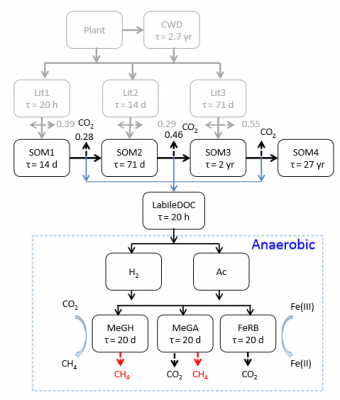Explicit Aqueous Phase Redox and pH Dynamics Added to the Converging Trophic Cascade (CTC) Decomposition Model
Explicit aqueous phase redox, pH, and mineral interaction dynamics were coupled to the Converging Trophic Cascade (CTC) decomposition model, enabling prediction of CO2 and CH4 production from Arctic polygonal tundra soils under laboratory incubations over a range of temperatures. Our results demonstrate the efficacy of using geochemical models to mechanistically represent the soil biogeochemical processes for Earth system models.
Soil organic carbon turnover and CO2 and CH4 production are sensitive to redox potential and pH. However, land surface models typically do not explicitly simulate the redox or pH, particularly in the aqueous phase, introducing uncertainty in greenhouse gas predictions. The modeling approach demonstrated in this work will be evaluated against additional field and laboratory data, and will be incorporated in new Earth system modeling development to improve prediction of greenhouse gas fluxes in Arctic tundra environments.
Soil organic carbon turnover and CO2 and CH4 production are sensitive to redox potential and pH. However, land surface models typically do not explicitly simulate the redox or pH, particularly in the aqueous phase, introducing uncertainty in greenhouse gas predictions. To account for the impact of availability of electron acceptors other than O2 on soil organic matter (SOM) decomposition and methanogenesis, we extended an existing decomposition cascade model (the Converging Trophic Cascade model, or CTC) to link complex polymers with simple substrates and add Fe(III) reduction and methanogenesis reactions. Because pH was observed to change substantially in the laboratory incubation tests and in the field and is a sensitive environmental variable for biogeochemical processes, we use the Windermere Humic Aqueous Model (WHAM) to simulate pH buffering by SOM. To account for the speciation of CO2 among gas, aqueous, and solid (adsorbed) phases under varying pH, temperature, and pressure values, as well as the impact on typically measured headspace concentration, we use a geochemical model and an established reaction database to describe observations in anaerobic microcosms incubated at a range of temperatures (-2, +4, and +8 °C). Our results demonstrate the efficacy of using geochemical models to mechanistically represent the soil biogeochemical processes for Earth system models. The modeling approach demonstrated in this work will be evaluated against additional field and laboratory data, and will be incorporated in new Earth system modeling development to improve prediction of greenhouse gas fluxes in Arctic tundra environments.

